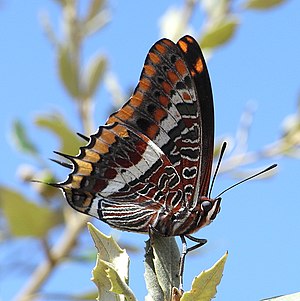Strawberry tree butterfly
| Strawberry tree butterfly | ||||||||||||
|---|---|---|---|---|---|---|---|---|---|---|---|---|

Strawberry Tree Butterfly ( Charaxes jasius ) |
||||||||||||
| Systematics | ||||||||||||
|
||||||||||||
| Scientific name | ||||||||||||
| Charaxes jasius | ||||||||||||
| ( Linnaeus , 1766) |
The strawberry tree butterfly ( Charaxes jasius ) is a butterfly in the noble butterfly family (Nymphalidae). It is the largest European butterfly .
description
butterfly
The bright dark brown upper sides of the wing have a broad yellow-brown band and spots of the same color in the post-disk region . On the upper side of the hind wings, each with two spurs (tails), there is a row of blue spots in cells 1c - 4. The underside is strongly patterned with stripes and spots. The female is slightly larger than the male and has a forewing length of over 40 millimeters and a wingspan of over nine centimeters. The butterfly cannot be confused with other species in Europe.
Caterpillar
The caterpillars are colored green and have a light, yellowish side stripe. They are similar to snails in that their head capsule has four reddish-brown horns pointing upwards, of which the two middle ones stand out. The end of the body is wide and slightly crescent-shaped indented towards the body. Even the caterpillars have this external shape, only the color is yellowish in the first stage.
Way of life
The strawberry tree butterfly flies in two generations from May to June and August to September. He is a good and fast flier and can be watched for hours while flying through his territory. Conspecifics and even small birds are vigorously driven away. When it settles down, it almost always folds its wings - similar to the brimstone butterfly .
The caterpillars live on the western strawberry tree ( Arbutus unedo ). They each have a resting place; there they spin a web in the middle of the leaf surface. The caterpillars return to this resting place, which can be changed frequently in the course of development, during the feeding breaks, as they usually migrate to other leaves to eat. The moth loves and visits burst, fermenting fruit, sweat and excrement. He is often so intoxicated by fermented fruits that he is no longer able to fly. In September it can often be seen sucking on overripe, fermented figs ( Ficus ) or other fruits.
The yellowish, 2 mm large eggs are deposited either on the lower or upper side of the leaves. The caterpillars pupate on their food plant. The greenish-white pupa, which is regularly oval in shape, appears relatively short and stocky in relation to the size of the butterfly.
distribution
The distribution of the strawberry tree is strongly linked to the distribution of the strawberry tree, the caterpillar's forage plant. In contrast to the forage plant, which can withstand temperatures of up to −15 ° C, the overwintering caterpillars do not survive longer periods of frost. The strawberry tree butterfly occurs in the coastal areas of the Mediterranean Sea to central Africa. In Europe and North Africa the distribution includes Algeria , Morocco , Tunisia and Tuscany , furthermore western Portugal , the Balearic Islands , Corsica , Elba , Sardinia , Sicily , Corfu , Crete , Samos , Ikaria , Chios and Rhodes . There are isolated domestic populations in Spain ( Huelva , Málaga , Salamanca and Madrid ) and France ( Provence to Aveyron , Lozère and Ardèche ). It is absent from the north Adriatic coast. In the vertical distribution it reaches heights of up to 1200 meters, in the High Atlas of up to 2400 meters. It is mostly found in partially shaded areas such as bushes and on the edges of forests. But it also occurs in settlement areas.
status
It is quite common locally.
swell
Individual evidence
- ^ Lionel G. Higgins, Norman D. Riley: The butterflies of Europe and Northwest Africa . 1st edition. Paul Parey, Hamburg / Berlin 1978, ISBN 3-490-01918-0 .
- ↑ a b Elizabeth Balmer: Butterflies: Recognize and determine. Parragon Books, 2007, ISBN 9781407512037 , p. 105
- ↑ Heiko Bellmann: Steinbach's nature guide. Butterflies Ulmer, Stuttgart (Hohenheim), 2010 ISBN 978-3-8001-4653-6
- ↑ Tom Tolman, Richard Lewington: The butterflies of Europe and Northwest Africa . Franckh-Kosmos, Stuttgart 1998, ISBN 3-440-07573-7 .
Web links
- Lepiforum e. V. Taxonomy and Photos
- www.schmetterling-raupe.de
- Moths and Butterflies of Europe and North Africa (English)
- Charaxes jasius at Fauna Europaea


